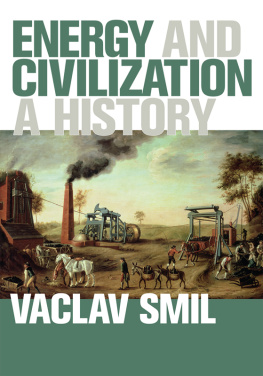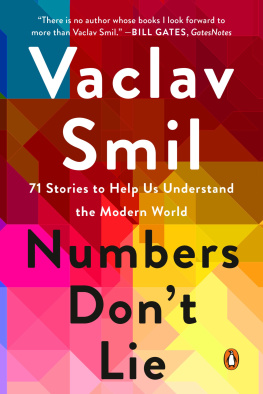
Vaclav Smil
HOW THE WORLD REALLY WORKS
A Scientists Guide to Our Past, Present and Future

Contents
- Introduction:
Why Do We Need This Book? - 1. Understanding Energy:
Fuels and Electricity - 2. Understanding Food Production:
Eating Fossil Fuels - 3. Understanding Our Material World:
The Four Pillars of Modern Civilization - 4. Understanding Globalization:
Engines, Microchips, and Beyond - 5. Understanding Risks:
From Viruses to Diets to Solar Flares - 6. Understanding the Environment:
The Only Biosphere We Have - 7. Understanding the Future:
Between Apocalypse and Singularity - Appendix: Understanding Numbers:
Orders of Magnitude
About the Author
Vaclav Smil is Distinguished Professor Emeritus at the University of Manitoba. He is the author of over forty books on topics including energy, environmental and population change, food production and nutrition, technical innovation, risk assessment and public policy. His most recent for Penguin was Numbers Dont Lie, which was published in over twenty languages. No other living scientist has had more books (on a wide variety of topics) reviewed in the leading scientific journal Nature. A Fellow of the Royal Society of Canada, in 2010 he was named by Foreign Policy as one of the Top 100 Global Thinkers.
Introduction
Why Do We Need This Book?
Every era has its claims to uniqueness, but while the experiences of the past three generationsthat is, the decades since the end of the Second World Warmay not have been as fundamentally transformative as those of the three generations preceding the beginning of the First World War, there has been no shortage of unprecedented events and advances. Most impressively, more people now enjoy a higher standard of living, and do so for more years and in better health, than at any time in history. Yet these beneficiaries are still a minority (only about a fifth) of the worlds population, whose total count is approaching 8 billion people.
The second achievement to admire is the unprecedented expansion of our understanding of both the physical world and all forms of life. Our knowledge extends from grand generalizations about complex systems on the universal (galaxies, stars) and planetary (atmosphere, hydrosphere, biosphere) scale to processes at the level of atoms and genes: lines etched into the surface of the most powerful microprocessor are only about twice the diameter of human DNA. We have translated this understanding into a still-expanding array of machines, devices, procedures, protocols, and interventions that sustain modern civilization, and the enormity of our aggregate knowledgeand the ways we have deployed it in our serviceis far beyond the comprehension of any individual mind.
You could meet real Renaissance men on Florences Piazza Signoria in 1500but not for too long after that. By the middle of the 18th century two French savants, Denis Diderot and Jean le Rond dAlembert, could still gather a group of knowledgeable contributors to sum up the eras understanding in fairly exhaustive entries in their multi-volume Encyclopdie, ou Dictionnaire raisonn des sciences, des arts et des mtiers. A few generations later the extent and the specialization of our knowledge advanced by orders of magnitude, with fundamental discoveries ranging from magnetic induction (Michael Faraday in 1831, the basis of electricity generation) to plant metabolism (Justus von Liebig, 1840, the basis of crop fertilization) to theorizing about electromagnetism (James Clerk Maxwell, 1861, the basis of all wireless communication).
In 1872, a century after the appearance of the last volume of the Encyclopdie, any collection of knowledge had to resort to the superficial treatment of a rapidly expanding range of topics, and, one and a half centuries later, it is impossible to sum up our understanding even within narrowly circumscribed specialties: such terms as physics or biology are fairly meaningless labels, and experts in particle physics would find it very hard to understand even the first page of a new research paper in viral immunology. Obviously, this atomization of knowledge has not made any public decision-making easier. Highly specialized branches of modern science have become so arcane that many people employed in them are forced to train until their early or mid-thirties in order to join the new priesthood.
They may share long apprenticeships, but too often they cannot agree on the best course of action. The SARS-CoV-2 pandemic made it clear that disagreements among experts may extend even to such seemingly simple decisions as wearing a face mask. By the end of March 2020 (three months into the pandemic) the World Health Organization still advised against doing so unless a person was infected, and the reversal came only in early June 2020. How can those without any special knowledge take sides or make any sense of these disputes that now often end in retractions or the dismantling of previously dominant claims?
Still, such continuing uncertainties and disputes do not excuse the extent to which most people misunderstand the fundamental workings of the modern world. After all, appreciating how wheat is grown () are not the same as asking that somebody comprehend femtochemistry (the study of chemical reactions at timescales of 10-15 seconds, Ahmed Zewail, Nobel Prize in 1999) or polymerase chain reactions (the rapid copying of DNA, Kary Mullis, Nobel Prize in 1993).
Why then do most people in modern societies have such a superficial knowledge about how the world really works? The complexities of the modern world are an obvious explanation: people are constantly interacting with black boxes, whose relatively simple outputs require little or no comprehension of what is taking place inside the box. This is as true of such ubiquitous devices as mobile phones and laptops (typing a simple query does the trick) as it is of mass-scale procedures such as vaccination (certainly the best planetary example of 2021, with, typically, the rolling up of a sleeve being the only comprehensible part). But explanations of this comprehension deficit go beyond the fact that the sweep of our knowledge encourages specialization, whose obverse is an increasingly shallow understandingeven ignoranceof the basics.
Urbanization and mechanization have been two important reasons for this comprehension deficit. Since the year 2007, more than half of humanity has lived in cities (more than 80 percent in all affluent countries), and unlike in the industrializing cities of the 19th and early 20th centuries, jobs in modern urban areas are largely in services. Most modern urbanites are thus disconnected not only from the ways we produce our food but also from the ways we build our machines and devices, and the growing mechanization of all productive activity means that only a very small share of the global population now engages in delivering civilizations energy and the materials that comprise our modern world.
America now has only about 3 million men and women (farm owners and hired labor) directly engaged in producing foodpeople who actually plow the fields, sow the seeds, apply fertilizer, eradicate weeds, harvest the crops (picking fruit and vegetables is the most labor-intensive part of the process), and take care of the animals. That is less than 1 percent of the countrys population, and hence it is no wonder that most Americans have no idea, or only some vague notion, about how their bread or their cuts of meat came to be. Combines harvest wheatbut do they also harvest soybeans or lentils? How long does it take for a tiny piglet to become a pork chop: weeks or years? The vast majority of Americans simply dont knowand they have plenty of company. China is the worlds largest producer of steelsmelting, casting, and rolling nearly a billion tons of it every yearbut all of that is done by less than 0.25 percent of Chinas 1.4 billion people. Only a tiny percentage of the Chinese population will ever stand close to a blast furnace, or see the continuous casting mill with its red ribbons of hot, moving steel. And this disconnect is the case across the world.
Next page
















